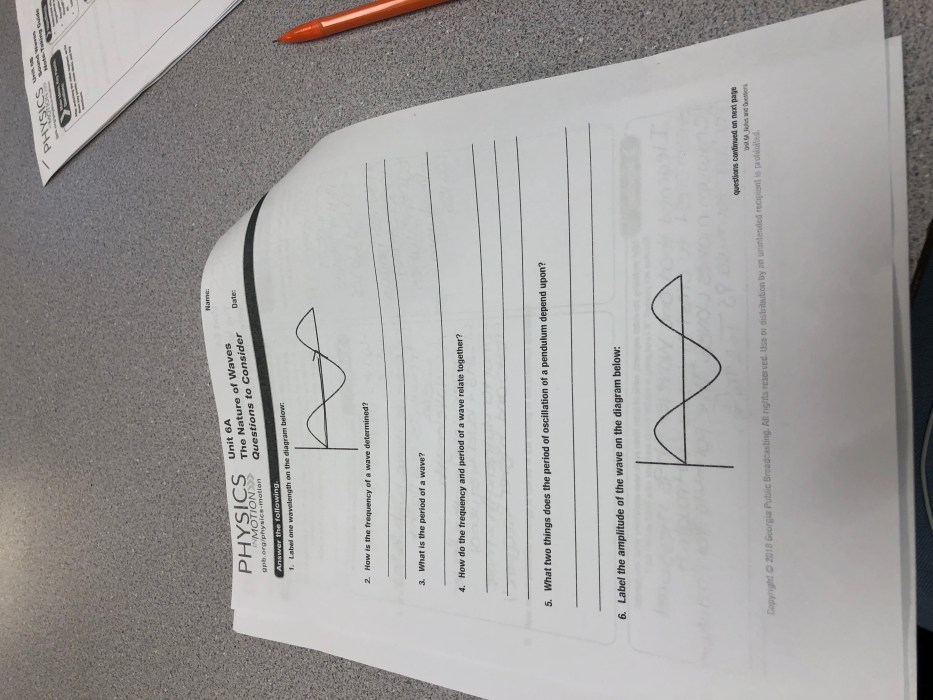Embark on an enlightening journey with Physics in Motion Unit 6A Answers, your comprehensive guide to mastering the fundamental principles that govern the motion of objects. This meticulously crafted resource delves into the depths of Newton’s Laws, Momentum, Energy, Circular Motion, Friction, and Air Resistance, unraveling the intricate workings of the physical world.
Prepare to witness the seamless interplay of theory and practice as we explore real-world applications, conduct captivating experiments, and engage in thought-provoking discussions. With Physics in Motion Unit 6A Answers as your steadfast companion, you will emerge as a master of motion, capable of deciphering the complexities of the dynamic world around you.
Newton’s Laws of Motion
Newton’s Laws of Motion provide the foundation for understanding the behavior of objects in motion. They describe the relationship between an object’s mass, velocity, and the forces acting upon it.
Newton’s First Law of Motion (Law of Inertia), Physics in motion unit 6a answers
An object at rest stays at rest and an object in motion stays in motion with the same speed and in the same direction unless acted upon by an unbalanced force.
Newton’s Second Law of Motion (Law of Acceleration)
The acceleration of an object is directly proportional to the net force acting on the object, and inversely proportional to its mass.
Newton’s Third Law of Motion (Law of Action-Reaction)
For every action, there is an equal and opposite reaction.
Applications of Newton’s Laws
Newton’s Laws of Motion have wide-ranging applications in everyday life and various fields.
- Transportation:Newton’s Laws govern the motion of vehicles, including cars, airplanes, and rockets.
- Engineering:Engineers use Newton’s Laws to design structures, bridges, and machines.
- Sports:Athletes rely on Newton’s Laws to optimize their performance in activities such as running, jumping, and throwing.
- Medicine:Newton’s Laws are essential in understanding the dynamics of the human body, such as the forces involved in walking and lifting.
Momentum and Impulse
Momentum is a measure of an object’s mass and velocity, while impulse is the product of force and time.
Relationship between Momentum and Impulse
The impulse applied to an object is equal to the change in its momentum.
Energy in Motion

Energy associated with motion takes different forms, including kinetic and potential energy.
Kinetic Energy
Kinetic energy is the energy of an object in motion.
Potential Energy
Potential energy is the energy stored in an object due to its position or condition.
Circular Motion and Centripetal Force
Circular motion occurs when an object moves in a circular path. Centripetal force is the force that keeps the object moving in a circular path.
Examples of Objects Undergoing Circular Motion
- A car going around a curve
- A satellite orbiting the Earth
- A ball on a string being swung in a circle
Friction and Air Resistance
Friction is a force that opposes the motion of objects in contact with a surface. Air resistance is a type of friction that acts on objects moving through air.
Effects of Friction and Air Resistance on Moving Objects
- Friction:Reduces the speed of moving objects, generates heat, and can cause wear and tear.
- Air Resistance:Slows down objects moving through air, affects the trajectory of projectiles, and influences the design of aircraft.
FAQ Explained: Physics In Motion Unit 6a Answers
What is the significance of Newton’s First Law of Motion?
Newton’s First Law establishes the concept of inertia, stating that an object at rest will remain at rest, and an object in motion will maintain its motion with constant velocity unless acted upon by an external force.
How does momentum relate to impulse?
Momentum, a measure of an object’s motion, is directly proportional to the impulse applied to it. Impulse, in turn, is the product of force and the time over which it is applied.
What is the difference between kinetic and potential energy?
Kinetic energy is the energy possessed by an object due to its motion, while potential energy is the energy stored within an object due to its position or configuration.


